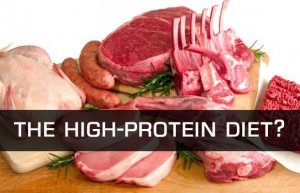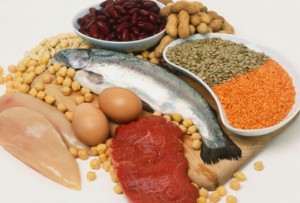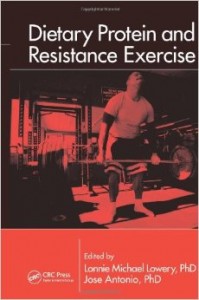By Alan Aragon
(Note: this article was originally posted at: www.wannabebig.com )
Introduction
 A longstanding belief in fitness circles is that the body can only use a certain amount of protein per meal, and the excess is either oxidized or excreted. The ballpark range thrown around is 20-30 grams, with 30 grams being perhaps the most common figure. This guideline has led many trainees to go through the pains of consuming multiple doses of protein throughout the day, banking that it will maximize muscle anabolism or muscle retention. Well, true or not, this concept fits in nicely with another longstanding fitness “rule” that you have to eat at least six times per day in order to keep the body’s metabolism revving high. Since the meal frequency and metabolism dogma has been thoroughly debunked [1-5], it’s time to dig into the topic of whether there’s a limit to effective protein dosing, and if so, what that limit might be.
A longstanding belief in fitness circles is that the body can only use a certain amount of protein per meal, and the excess is either oxidized or excreted. The ballpark range thrown around is 20-30 grams, with 30 grams being perhaps the most common figure. This guideline has led many trainees to go through the pains of consuming multiple doses of protein throughout the day, banking that it will maximize muscle anabolism or muscle retention. Well, true or not, this concept fits in nicely with another longstanding fitness “rule” that you have to eat at least six times per day in order to keep the body’s metabolism revving high. Since the meal frequency and metabolism dogma has been thoroughly debunked [1-5], it’s time to dig into the topic of whether there’s a limit to effective protein dosing, and if so, what that limit might be.
Looking at simple logic first
Let’s imagine an experiment involving two relatively lean 200 lb individuals. For the purposes of this illustration, I’ll assign a daily amount of protein known to adequately support the needs of the athletic population. We’ll give Person A 150 g protein spread over five meals at 30 g each. We’ll give Person B the same amount of protein, but in a single meal. Let’s say that this meal consists of a 16 oz steak, chased with a shake containing two scoops of protein powder. If we really believed that only 30 g protein can be handled by the body in a single meal, then Person B would eventually run into protein deficiency symptoms because he supposedly is only absorbing a total of 30 g out of the 150 g we’re giving him. At 30 g/day, he’s only getting 0.33 g/kg of bodyweight, which isn’t even half of the already-low RDA of 0.8 g/kg. If the body worked this way, the human species would have quickly become extinct. The human body is more efficient and effective than we give it credit for. The body will take all the sweet time it needs to effectively digest and absorb just about whatever dose you give it. Person A will have shorter digestion periods per meal in order to effectively absorb and utilize the small meals. Person B will have a longer digestion period in order to effectively absorb and utilize the large meal. While the truth in this logic seems self-evident, the important question is whether or not it’s supported by scientific research. Let’s look at the evidence, starting with immediate-effect (acute) studies, then move on to the longer-term trials.
Research examining speed of absorption
A thorough literature review by Bilsborough and Mann compiled data from studies by various investigators who measured the absorption rates of various protein sources [6]. Oddly, an amino acid mixture designed to mimic the composition of pork tenderloin made the top spot, at 10 g/hour, while whey took a close second at 8-10 g/hour. Other proteins fell in their respective spots below the top two, with little rhyme or reason behind the outcomes. As a matter of trivia, raw egg protein was the most slowly absorbed of them all at 1.3 g/hour. It’s important to note that these data have some serious limitations. A major one is the variance of the methods used to determine the absorption rates (i.e., intravenous infusion, oral ingestion, ileal ingestion). Most of the methods are just too crude or far-fetched for serious consideration. Another limitation is that these figures could be skewed depending upon their concentration in solution, which can affect their rate of gastric evacuation. Another factor to consider is the timing of ingestion relative to exercise and how that might differentially affect absorption rates. Finally, short-term data leaves a lot open to question.
Short-term research supporting the magic limit
I’ve heard many folks parrot that the maximal anabolic effect of a single protein dose is limited to 20 grams, citing recent work by Moore and colleagues [7]. In this study’s 4-hour post-exercise test period, 40 g protein did not elicit a greater anabolic response than 20 g. I’d interpret these outcomes with caution. Fundamentally speaking, protein utilization can differ according to muscle mass. The requirements of a 140-lb person will differ markedly from someone who’s a lean 200. Additionally, a relatively low amount of total volume was used (12 sets total). Typical training bouts usually involve more than one muscle group and are commonly at least double that volume, which can potentially increase the demand for nutrient uptake. Finally, the conclusion of the authors is questionable. They state explicitly,
“…we speculate that no more than 5-6 times daily could one ingest this amount (~20 g) of protein and expect muscle protein synthesis to be maximally stimulated.”
So, they’re implying that 100-120 grams of protein per day is maximal for promoting muscle growth. Wait a minute, what? Based on both the bulk of the research evidence and numerous field observations, this is simply false [8,9]. In another recent study, Symons and colleagues compared the 5-hour response of a moderate serving of lean beef containing 30 g protein with a large serving containing 90 g protein [10]. The smaller serving increased protein synthesis by approximately 50%, and the larger serving caused no further increase in protein synthesis, despite being triple the dose. The researchers concluded that the ingestion of more than 30 g protein in a single meal does not further enhance muscle protein synthesis. While their conclusion indeed supports the outcomes of their short-term study, it’s pretty easy to predict the outcomes in muscle size and strength if we compared a total daily protein dose of 90 g with 30 g over a longer trial period, let alone one involving a structured exercise protocol. This brings me to the crucial point that acute outcomes merely provide grounds for hypothesis. It’s not completely meaningless, but it’s far from conclusive without examining the long-term effects.
Longer-term research challenging the magic limit
If we were to believe the premise that a 20-30 g dose of protein yields a maximal anabolic effect, then it follows that any excess beyond this dose would be wasted. On the contrary, the body is smarter than that. In a 14-day trial, Arnal and colleagues found no difference in fat-free mass or nitrogen retention between consuming 79% of the day’s protein needs (roughly 54 g) in one meal, versus the same amount spread across four meals [11]. Notably, this study was done on young female adults whose fat-free mass averaged 40.8 kg (89.8 lb). Considering that most non-sedentary males have considerably more lean mass than the female subjects used in the aforementioned trial, it’s plausible that much more than 54 g protein in a single meal can be efficiently processed for anabolic and/or anti-catabolic purposes. If we extrapolated the protein dose used in this study (79% of 1.67g/kg) to the average adult male, it would be roughly 85-95 g or even more, depending on just how close someone is to the end of the upper limits of muscular size. When Arnal and colleagues applied the same protocol to the elderly population, the single-dose treatment actually caused better muscle protein retention than the multiple-dose treatment [12]. This raises the possibility that as we age, larger protein feedings might be necessary to achieve the same effect on protein retention as lesser amounts in our youth.
Intermittent Fasting research nailing the coffin shut?
Perhaps the strongest case against the idea of a dosing limit beyond which anabolism or muscle retention can occur is the recent intermittent fasting (IF) research, particularly the trials with a control group on a conventional diet. For example, Soeters and colleagues compared two weeks of IF involving 20-hour fasting cycles with a conventional diet [13]. Despite the IF group’s consumption of an average of 101 g protein in a 4-hour window, there was no difference in preservation of lean mass and muscle protein between groups. In another example, Stote and colleagues actually reported an improvement in body composition (including an increase in lean mass) after 8 weeks in the IF group consuming one meal per day, where roughly 86 g protein was ingested in a 4-hour window [14]. Interestingly, the conventional group consuming three meals spread throughout the day showed no significant body composition improvements. Keep in mind that bioelectrical impedance (BIA) was used to determine body composition, so these outcomes should be viewed with caution. I’ve been highly critical of this study in the past, and I still am. Nevertheless, it cannot be completely written off and must be factored into the body of evidence against the idea of a magic protein dose limit.
Conclusion & application
Based on the available evidence, it’s false to assume that the body can only use a certain amount of protein per meal. Studies examining short-term effects have provided hints towards what might be an optimal protein dose for maximizing anabolism, but trials drawn out over longer periods haven’t supported this idea. So, is there a limit to how much protein per meal can be effectively used? Yes there is, but this limit is  likely similar to the amount that’s maximally effective in an entire day. What’s the most protein that the body can effectively use in an entire day? The short answer is, a lot more than 20-30 g. The long answer is, it depends on several factors. In most cases it’s not too far from a gram per pound in drug-free trainees, given that adequate total calories are provided [8,9]. In terms of application, I’ve consistently observed the effectiveness of having approximately a quarter of your target bodyweight in both the pre- and post-exercise meal. Note: target bodyweight is a surrogate index of lean mass, and I use that to avoid making skewed calculations in cases where individuals are markedly over- or underweight. This dose surpasses the amounts seen to cause a maximal anabolic response but doesn’t impinge upon the rest of the day’s protein allotment, which can be distributed as desired. On days off from training, combine or split up your total protein allotment according to your personal preference and digestive tolerance. I realize that freedom and flexibility are uncommon terms in physique culture, but maybe it’s time for a paradigm shift. In sum, view all information – especially gym folklore and short-term research – with caution. Don’t buy into the myth that protein won’t get used efficiently unless it’s dosed sparingly throughout the day. Hopefully, future research will definitively answer how different dosing schemes with various protein types affect relevant endpoints such as size and strength. In the mean time, feel free to eat the whole steak and drink the whole shake, and if you want to get the best bang for your buck, go for a quality protein blend such as Nitrean! (http://www.atlargenutrition.com/products/nitrean-46)
likely similar to the amount that’s maximally effective in an entire day. What’s the most protein that the body can effectively use in an entire day? The short answer is, a lot more than 20-30 g. The long answer is, it depends on several factors. In most cases it’s not too far from a gram per pound in drug-free trainees, given that adequate total calories are provided [8,9]. In terms of application, I’ve consistently observed the effectiveness of having approximately a quarter of your target bodyweight in both the pre- and post-exercise meal. Note: target bodyweight is a surrogate index of lean mass, and I use that to avoid making skewed calculations in cases where individuals are markedly over- or underweight. This dose surpasses the amounts seen to cause a maximal anabolic response but doesn’t impinge upon the rest of the day’s protein allotment, which can be distributed as desired. On days off from training, combine or split up your total protein allotment according to your personal preference and digestive tolerance. I realize that freedom and flexibility are uncommon terms in physique culture, but maybe it’s time for a paradigm shift. In sum, view all information – especially gym folklore and short-term research – with caution. Don’t buy into the myth that protein won’t get used efficiently unless it’s dosed sparingly throughout the day. Hopefully, future research will definitively answer how different dosing schemes with various protein types affect relevant endpoints such as size and strength. In the mean time, feel free to eat the whole steak and drink the whole shake, and if you want to get the best bang for your buck, go for a quality protein blend such as Nitrean! (http://www.atlargenutrition.com/products/nitrean-46)
BIO
 Alan Aragon has over 15 years of success in the fitness field. He earned his Bachelor and Master of Science in Nutrition with top honors. Alan is a continuing education provider for the Commission on Dietetic Registration, National Academy of Sports Medicine, American Council on Exercise, and National Strength & Conditioning Association. Alan recently lectured to clinicians at the FDA and the annual conference of the Los Angeles Dietetic Association. He maintains a private practice designing programs for recreational, Olympic, and professional athletes, including the Los Angeles Lakers, Los Angeles Kings, and Anaheim Mighty Ducks. Alan is a contributing editor and Weight Loss Coach of Men’s Health magazine. His book Girth Control is considered one of the most in-depth manuals for physique improvement and understanding nutrition for fitness & sports. Last but not least, Alan writes a monthly research review providing of the latest science on nutrition, training, and supplementation. Visit Alan’s blog to keep up with his latest shenanigans. For more information, go to www.alanaragonblog.com
Alan Aragon has over 15 years of success in the fitness field. He earned his Bachelor and Master of Science in Nutrition with top honors. Alan is a continuing education provider for the Commission on Dietetic Registration, National Academy of Sports Medicine, American Council on Exercise, and National Strength & Conditioning Association. Alan recently lectured to clinicians at the FDA and the annual conference of the Los Angeles Dietetic Association. He maintains a private practice designing programs for recreational, Olympic, and professional athletes, including the Los Angeles Lakers, Los Angeles Kings, and Anaheim Mighty Ducks. Alan is a contributing editor and Weight Loss Coach of Men’s Health magazine. His book Girth Control is considered one of the most in-depth manuals for physique improvement and understanding nutrition for fitness & sports. Last but not least, Alan writes a monthly research review providing of the latest science on nutrition, training, and supplementation. Visit Alan’s blog to keep up with his latest shenanigans. For more information, go to www.alanaragonblog.com
References
1. Smeets AJ, Westerterp-Plantenga MS. Acute effects on metabolism and appetite profile of one meal difference in the lower range of meal frequency. Br J Nutr. 2008 Jun;99(6):1316-21.
2. Taylor MA, Garrow JS. Compared with nibbling, neither gorging nor a morning fast affect short-term energy balance in obese patients in a chamber calorimeter. Int J Obes Relat Metab Disord. 2001 Apr;25(4):519-28.
3. Bellisle F, McDevitt R, Prentice AM. Meal frequency and energy balance. Br J Nutr. 1997 Apr;77 Suppl 1:S57-70.
4. Verboeket-van de Venne WP, Westerterp KR. Frequency of feeding, weight reduction and energy metabolism. Int J Obes Relat Metab Disord. 1993 Jan;17(1):31-6.
5. Verboeket-van de Venne WP, Westerterp KR. Influence of the feeding frequency on nutrient utilization in man: consequences for energy metabolism. Eur J Clin Nutr. 1991 Mar;45(3):161-9.
6. Bilsborough S, Mann N. A review of issues of dietary protein intake in humans. Int J Sport Nutr Exerc Metab. 2006 Apr;16(2):129-52.
7. Moore DR, et al. Ingested protein dose response of muscle and albumin protein synthesis after resistance exercise in young men. Am J Clin Nutr. 2009 Jan;89(1):161-8.
8. Campbell B, et al. International Society of Sports Nutrition position stand: protein and exercise. J Int Soc Sports Nutr. 2007 Sep 26;4:8.
9. Tipton KD, Wolfe RR. Protein and amino acids for athletes. J Sports Sci. 2004 Jan;22(1):65-79.
10. Symons TB, et al. A moderate serving of high-quality protein maximally stimulates skeletal muscle protein synthesis in young and elderly subjects. J Am Diet Assoc. 2009 Sep;109(9):1582-6.
11. Arnal MA, et al. Protein feeding pattern does not affect protein retention in young women. J Nutr. 2000 Jul;130(7):1700-4.
12. Arnal MA, et al. Protein pulse feeding improves protein retention in elderly women. Am J Clin Nutr. 1999 Jun;69(6):1202-8.
13. Soeters MR, et al. Intermittent fasting does not affect whole-body glucose, lipid, or protein metabolism. Am J Clin Nutr. 2009 Nov;90(5):1244-51.
14. Stote KS, et al. A controlled trial of reduced meal frequency without caloric restriction in healthy, normal-weight, middle-aged adults. Am J Clin Nutr. 2007 Apr;85(4):981-8
 go: they include the amino acids valine, leucine and isoleucine. They are part of the family of essential amino acids in which leucine plays the key role in promoting muscle protein anabolism, or synthesis. For those who are active and looking to increase performance and perhaps muscle mass, BCAAs may be worth taking. Here’s the short story of how the BCAAs might act as an ergogenic aid. During prolonged exercise, plasma tryptophan (another amino acid) rises resulting in feelings of fatigue. Research, however, shows that if you consume BCAAs, it may compete with free tryptophan; thus reducing your perception of fatigue. The result is that less tryptophan goes to your brain, you get less fatigued, and experience higher performance! Interesting…The effective dose is ~5 to 20 g. This can still be easily reached with protein-rich foods; however, the data on BCAAs regarding its ergogenic properties are on the three amino acids as a stand-alone supplement (not as part of a food).
go: they include the amino acids valine, leucine and isoleucine. They are part of the family of essential amino acids in which leucine plays the key role in promoting muscle protein anabolism, or synthesis. For those who are active and looking to increase performance and perhaps muscle mass, BCAAs may be worth taking. Here’s the short story of how the BCAAs might act as an ergogenic aid. During prolonged exercise, plasma tryptophan (another amino acid) rises resulting in feelings of fatigue. Research, however, shows that if you consume BCAAs, it may compete with free tryptophan; thus reducing your perception of fatigue. The result is that less tryptophan goes to your brain, you get less fatigued, and experience higher performance! Interesting…The effective dose is ~5 to 20 g. This can still be easily reached with protein-rich foods; however, the data on BCAAs regarding its ergogenic properties are on the three amino acids as a stand-alone supplement (not as part of a food).







